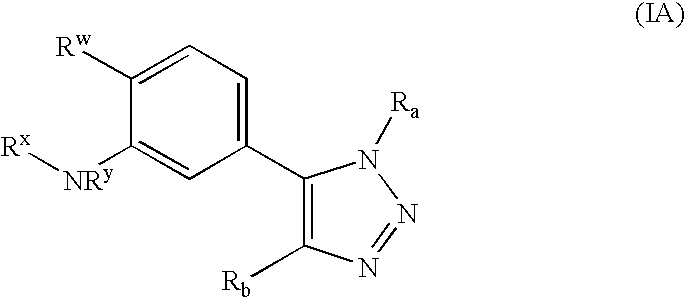Compounds for the treatment of proliferative disorders
a proliferative disorder and compound technology, applied in the field of biologically active chemical compounds, can solve the problems of limiting the use of repeat therapy, affecting cell proliferation, and inhibiting the assembly or disassembly of microtubules,
- Summary
- Abstract
- Description
- Claims
- Application Information
AI Technical Summary
Benefits of technology
Problems solved by technology
Method used
Image
Examples
specific embodiments
[0105] The invention relates to compounds and pharmaceutical compositions that are useful for inhibiting tubulin polymerization and are particularly useful in treating or preventing proliferative disorders, such as cancer. The invention also relates to compounds and pharmaceutical compositions that are useful as vascular targeting agents, particularly, in blocking, occluding, or otherwise disrupting blood flow in neovasculature.
[0106] In one embodiment, the invention relates to compounds of formula (I): [0107] or a pharmaceutically acceptable salt, solvate, clathrate, or prodrug thereof, wherein Ra, Rb, and R2 are defined as above. In another embodiment, in the compounds represented by formula (I), Ra is not acridinyl.
[0108] In another embodiment, the invention relates to compounds of formula (II): [0109] or a pharmaceutically acceptable salt, solvate, clathrate, or prodrug thereof, wherein: [0110] one of Rc or Rd is —H and the other is [0111] Ring A is optionally substituted; ...
example 1
Synthesis of Representative Exemplary Compounds of this Invention
Compound 3: 1-(3,4,5-trimethoxy-phenyl)-5-(4-methoxy-phenyl)-1H-[1,2,3]triazole
[0863]
Step (a): Synthesis of 3,4,5-Trimethoxyphenyl azide
[0864] 3,4,5-Trimethoxyaniline (1.83 g; 10 mmol) is added to a 100 mL flask containing water (20 mL) and HCl (conc. aqueous solution, 5 mL). The solution is chilled to 0° C. and a solution of sodium nitrite (830 mg; 12 mmol) in water (5 mL) is added. The solution is stirred at 0° C. for 30 minutes, and then a solution of sodium azide (1.3 g; 20 mmol) in water (5 mL) is added. After another 30 minutes of stirring, dichloromethane is added (20 mL) and the organic phase was collected and filtered through a plug of silica, dried over magnesium sulfate and the solvent was evaporated to give approximately two grams of 3,4,5-trimethoxyphenyl azide.
[0865]1H-NMR (CDCl3) δ(ppm) 6.21 (s, 2H); 3.82 (s, 6H); 3.80 (s, 3H)
Step (b): Synthesis of 1-(3,4,5-trimethoxy-phenyl)-5-(4-methoxy-phenyl)-...
example 2
Cytotoxicity of Compounds of the Invention
[0876] The in vitro cytotoxicity of the compounds of the invention was determined in the following human cell lines: HL-60, HL-60-TX1000 (MDR), MES-SA and MES-SA / DX5 (uterine sarcoma). MES-SA is a model of uterine sarcoma, and the cells are sensitive to a number of chemotherapeutic agents including doxorubicin, dactinomycin, mitomycin C, taxol and bleomycin. The MES-SA / Dx5 cell line was established in the presence of increasing concentrations of doxorubicin. The cells express high levels of mdr-1 mRNA and p-glycoprotein and exhibit cross resistance to more than fifteen chemotherapeutic agents including taxol, etoposide, mitomycin C, colchicine, vinblastine, dactinomycin, 5-fluorouracil, methotrexate and so on. All cells except HL-60-TX1000 were purchased from ATCC. HL-60, a model of myeloid leukemia, was from ATCC and HL60 / TX1000 was a gift from Dr. Bhalla of Emory University School of Medicine. HL-60 / TX1000 was isolated in vitro by subcult...
PUM
| Property | Measurement | Unit |
|---|---|---|
| molecular weight | aaaaa | aaaaa |
| temperature | aaaaa | aaaaa |
| temperature | aaaaa | aaaaa |
Abstract
Description
Claims
Application Information
 Login to View More
Login to View More - R&D
- Intellectual Property
- Life Sciences
- Materials
- Tech Scout
- Unparalleled Data Quality
- Higher Quality Content
- 60% Fewer Hallucinations
Browse by: Latest US Patents, China's latest patents, Technical Efficacy Thesaurus, Application Domain, Technology Topic, Popular Technical Reports.
© 2025 PatSnap. All rights reserved.Legal|Privacy policy|Modern Slavery Act Transparency Statement|Sitemap|About US| Contact US: help@patsnap.com



